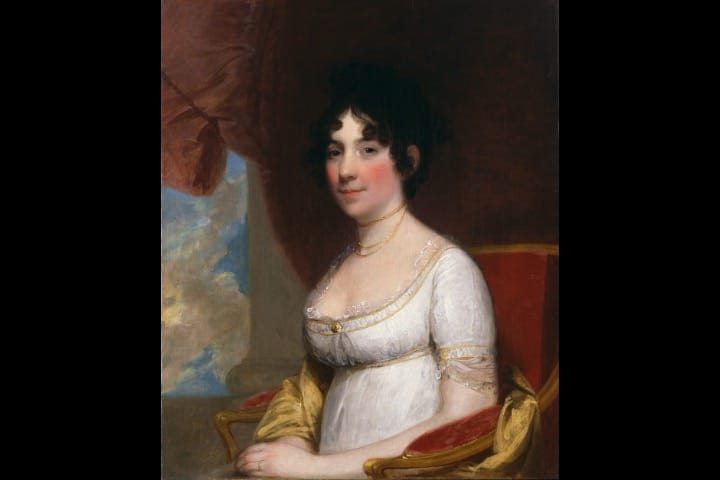
As strong, lasting, and inspirational as James Madison’s partnership with Thomas Jefferson was, it was nothing when compared to the love, friendship, and fidelity he shared with his devoted wife, Dolley. The story of their courtship and marriage is one rarely told today, but it is worthy of relating and emulating.
“[H]e hopes that your Heart will be calous [sic] to every other swain but himself.” Those words written in a letter to Dolley Payne Todd from her friend Catharine Cole on June 1, 1794 reveal a romantic side to James Madison that we rarely read about in other biographies and history textbooks.
There are good reasons for the lack of coverage of the lovesick, fawning follower in most descriptions of the relationship of James and Dolley Payne Todd. First, in the 18th century, the intimate details of courtship and marriage were just that: intimate. Public displays of affection and casual sharing of the correspondence between a man and a woman approaching marriage or already married were considered impolite and indecorous. Second, privacy in personal matters was thought to convey respect for the holy and cherished — something courtship and marriage were widely believed to be. So sacred were these relationships and the correspondence and convictions associated with them that Martha Washington destroyed General Washington’s letters to her upon his death.
Thankfully, many of the love letters exchanged by James and Dolley (and their trusted intermediaries such as Catharine Cole) remain extant and provide unique insight into the sights and sounds of a middle-aged, famous, influential, and committed bachelor and a young, beautiful, widow with whom he seems to have fallen instantly in love.
Dolley Payne Todd
There was much to love about Dolley Payne Todd. She was described as vivacious and even-tempered, qualities that attracted many men to her. Stories are told of how men would line up outside her father’s house just to take a turn trying to appeal to Dolley, the eldest of John Payne’s four daughters.
In 1790, some four years before she would meet the future president and her future second husband, Dolley married an up-and-coming Pennsylvania lawyer named John Todd. Todd was a Quaker, as was Dolley, and the two made a very good pair. Soon, two children — John Payne and William Temple — were born to Dolley and John. The young family was growing and life for the Todds seemed sweet and settled.
Sadly, the lives of the Todd family were soon shattered by the fatal effects of a yellow fever epidemic that devastated Philadelphia. Over five thousand people were killed within four months in 1793, including Dolley’s husband, John, and their three-month-old son, William Temple Todd. Even Dolley’s extended family was struck hard by the yellow fever outbreak; her husband’s parents also perished. Caring for his parents was likely what kept John himself in a weakened state, so weak that he succumbed to the worst of the disease’s attacks.
All told, nearly 20,000 people fled Philadelphia to avoid the ravages of the deadly plague. By the end of the epidemic, Dolley, then a widow of 25, and her young child were left nearly penniless. Unfortunately, Dolley was legally obligated to pay her late husband’s debts. Soon, though, the bequests left to her in her husband’s and father-in-law’s wills were paid to the young widow and she was able to turn her attention to the successful arrangement of her finances and the education of her son. At this point in the story, Dolley walked into the law office of the man who would introduce her to James Madison — Aaron Burr.
This wasn’t the first time Dolley met Mr. Burr, the charming congressman from New York. While in Philadelphia, he lived in her mother’s boarding house and thus became acquainted with Dolley and her late husband. There is some evidence that Dolley and Aaron Burr were close, though not necessarily in a romantic way. While sorting out schooling for her son, Dolley drew up a will of her own, naming Aaron Burr as the sole guardian of John Payne should she die before she remarried.
In the 18th century, young widows typically remarried rather quickly in order that they might have a household to care for and, if they had children, so that those children could be provided for and protected. Dolley was certainly a young widow, and by all accounts, she was very attractive, as well. According to Ralph Ketcham’s biography of James Madison, Dolley’s friend Elizabeth Collins described how “gentlemen would station themselves where they could see her pass.” In light of this fascination with her friend, Elizabeth scolded Dolley, “Really Dolley, thou must hide thy face, there are so many staring at thee.”
There is no doubt that Dolley was now financially stable and available. It seems no exaggeration to assert that she was certainly one of the most sought-after young women in Philadelphia in 1794. Dolley was not the only eligible single person in the city that summer, though. Congressman James Madison was unmarried, but at 43, many figured he was likely to stay that way. Enter Aaron Burr, Dolley Madison, and a lifelong love affair and happy marriage.
Meeting the “Great Little Madison”
Sometime in May 1794, James Madison asked his old schoolmate (he and Aaron Burr attended the College of New Jersey together) to introduce him to the young widow everybody talked about — Dolley Payne Todd. Aaron Burr graciously obliged.
“Thou must come to me. Aaron Burr says the great little Madison has asked to be brought to see me this evening,” Dolley wrote to her friend. Judging by the way she described James Madison, it is unlikely that this was her first time meeting the “great little Madison.” Madison traveled frequently to Philadelphia and on at least one occasion, he made a trip to Philadelphia with Dolley’s uncle, Isaac Coles, a member of Congress. In fact, Ketcham records that later in his life, Madison credited Coles with having introduced him to Dolley.
Little is known about what happened on James and Dolley’s first date. As described above, such events were not to be shared casually with anyone other than the couple’s closest friends and family. Ketcham’s biography recounts that Dolley wore a “mulberry-colored satin dress, a silk kerchief at her neck, and a tiny cap.” James Madison dressed up for the date, too, wearing, according to the same biography, “his new ‘Round Beaver’ hat.” The two made quite a well-dressed pair, and they must have hit it off quite well as they would be married less than four months later!
On September 15, 1794, James Madison, Jr. and Dolley Payne Todd were married in the home of George Steptoe Washington, General George Washington’s nephew and ward. The Reverend Alexander Balmain pronounced the couple man and wife, and thus began a marriage, a partnership, and a life of wedded bliss that would last forty-two years. In a letter written to her friend on the day she exchanged vows with James, Dolley wrote that she was uniting in holy matrimony “to the man who of all others I most admire.” She added that her marriage to Mr. Madison would bring to her “everything that is soothing and grateful in prospect.”
Life as Dolley’s husband apparently suited Mr. Madison, as one friend reported that marriage had made Madison “much more open and conversant than I had ever seen him before.” Others saw a subtle but welcome change in demeanor come across the new husband. One dinner guest of the Madisons described his host as “an incessant humorist,” adding that the company all delighted in hearing James’ stories “and his whimsical way of telling them.”
James and Dolley were happy and hospitable. They were in love with each other and in love with the life they would begin at home in Virginia, when his public duties were at last at an end.
The Madisons’ Family Life
For about two years after their wedding, the Madisons lived in Philadelphia while James served as a congressman representing his home district of Orange County, Virginia. They lived at the home of another renowned son of the Old Dominion: James Monroe. Monroe was overseas serving as the ambassador to France, and had graciously offered his friend the use of his house while he was away.
Madison, eager to get back to his own home — Montpelier — retired from Congress early in 1797, and he and Dolley left immediately for the Blue Ridge Mountains and the lush green grass of Virginia. Arriving at home, the Madisons settled in, along with Dolley’s son, John Todd (now five years old), and Anna Payne (Dolley’s little sister), and began improving the property and socializing with neighbors and relatives. Dolley was yet a young woman (she was only twenty-nine, some sixteen years younger than her husband), and she quickly acquired a reputation as a charming hostess, throwing delightful dinner parties at her new Virginia home.
Although James and Dolley had no children of their own, Montpelier was always home to the children of relatives. In fact, judging from the letters written by the Madisons and the biographies written about them, there were more than 20 children — mostly nieces, nephews, and young distant relations — running around Montpelier year in and year out. Though they were not parents of their own children, they were certainly caring guardians of the many children who lived in their home.
While living and working at their estate, the Madisons welcomed many famous Virginians to their home, including Thomas Jefferson, who in turn hosted the Madisons at Monticello twice a year until his death. Visitors enjoyed the convivial spirit always present at Montpelier. There are scores of letters written by guests of the Madisons describing the pair as friendly and fun. Of particular note in this regard is the memoir of her time at Montpelier written by Dolley’s niece, Mary Cutts. Mary’s account of the joy that James and Dolley shared as husband and wife and as best friends brings these two historical figures into full and living color. Mary wrote:
Mr. Madison dearly loved and was proud of his wife, the ornament of his house—she was his solace and comfort, he could not bear her to leave his presence, and she gratified him by being absent only when duty required. No matter how agreeably employed she was her first thought and instinct seemed to tell her when she was wanted—if engaged in conversation, she would quickly rise and say, “I must go to Madison.” On his return from riding round the plantation she would meet him at the door with refreshment in her own hands.
Years later, a regular visitor to Montpelier described the day she spent there in the company of James and Dolley:
Mr. and Mrs. Madison would in private sometimes romp and tease each other like two children, and engage in antics that would astonish the muse of history. Mrs. Madison was stronger as well as larger than he. She could—and did—seize his hands, draw him upon her back, and go around the room with him.
In every demonstrable way, James and Dolley were devoted to each other, devoted to their friends and family, and devoted to maintaining the mirth and magic of their courtship throughout the decades of their marriage.
“It Shall Never Fall Into the Hands of the Enemy”: Dolley Madison and the British Army’s Attack on the White House
Perhaps the most famous act of courage chronicled in the War of 1812 was made not by a soldier or sailor, but by Dolley Madison.
Although most of the battles of the War of 1812 were fought at sea, the British were determined to demolish the American capital, destroy her people’s resolve, and thus conquer the colonies they had lost in the War of Independence. To that end, 5,000 British troops landed in the United States and began their march toward Washington, D.C., their ultimate prize. A messenger was sent to the White House, informing the president that there were at least 50 British ships clogging the Potomac and the troops were within striking distance. President Madison knew he needed to call out the militia and alert them to the imminent threat to the capital. Accordingly, he called to the states to send the citizen-soldiers to the defense of their country and their families. Even here, however, President Madison held to his republican principles, reminding states to be frugal and wise, always “exerting all our vigilance on discovering the particular views of the enemy, and, by not prematurely or erroneously applying our means of defense, be more able to use them with effect where and when they become necessary.”
Mrs. Madison knew of the “views of the enemy” because she could practically see them! In a letter to Hannah Gallatin, she reported that British soldiers were “within 20 miles of the City [Washington, D.C.]. . . .” After midnight, a rider came to the White House, roused the Madisons, and informed the president that “The enemy are in full march for Washington.” Without knowing it, this was the last night the Madisons would spend in the White House.
President Madison rushed off to confer with his Cabinet and the military leaders, but not before asking his beloved wife, “Have you the courage to stay here till I come back, to-morrow or next day?” With courage, conviction, and palpable love for her husband and her country, Dolley responded, “I am not afraid of anything, if only you are not harmed and our army triumphs.”
With that, President Madison rode to a nearby hill to watch and command as the American militia fought bravely against the overwhelming British regulars. What the president saw gave him little hope of an American victory, and less of preserving the White House; thus, he quickly wrote a note to Dolley and sent it by a military messenger. The note said simply, “Enemy stronger than we heard at first. They may reach the city and destroy it. Be ready to leave at a moment’s warning.”
Later that afternoon, an American soldier galloped up to the White House, shouting, “Fly, fly! The house will be burned over your head!” Dolley secured a wagon from a friend and filled it with valuables. As she, some friends, and some servants were loading the silver and other goods onto the wagon, one of her friends reminded her that the British admiral of the fleet anchored in the Potomac threatened to take her and President Madison prisoner when the British occupied Washington, D.C. With that reminder ringing in her ears, Dolley was helped up into the wagon. Almost. Suddenly, Dolley remembered that there were a couple of things more valuable than all the silver and finery already secured in the wagon. She jumped down and ran back inside the White House.
The rest of the story is eloquently told by Grace Humphrey in her book Women in American History. As she jumped down from the wagon, Dolley declared:
“Not yet—the portrait of Washington—it shall never fall into the hands of the enemy. That must be taken away before I leave the house.”
The famous painting by Gilbert Stuart was in a heavy frame, screwed to the wall in the state dining-room, but in that frantic hurry there were no tools at hand to remove it.
“Get an axe and break the frame,” commanded Dolly Madison. She watched the canvas taken from the stretcher, saw it rolled up carefully, and sent to a place of safety. Later it was returned to her, and to-day hangs over the mantel in the red room of the White House.
One more delay—the Declaration of Independence was kept in a glass case, separate from the other state papers. Notwithstanding all the protests of her friends, Dolly Madison ran back into the house, broke the glass, secured the Declaration with the autographs of the signers, got into her carriage and drove rapidly away to [a] house beyond Georgetown.
None too soon did she leave. The sound of approaching troops was heard. The British were upon the city. They broke into the executive mansion, ransacked it, had dinner there in the state dining-room, stole what they could carry, and then set fire to the building.
With care for the priceless portrait of Washington and the historic Declaration of Independence, Dolley Madison, at the risk of being captured by British soldiers, proved herself a heroine of the War of 1812.



